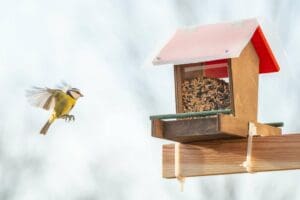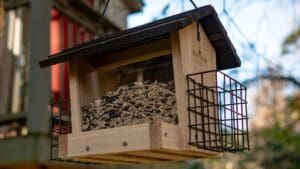How to Make Bird Feeders: A Step-by-Step Guide
Making bird feeders is a fun and easy way to attract garden birds to your backyard. Whether you’re an experienced birdwatcher or just starting out, providing food for birds is a great way to connect with nature and support local wildlife.
In this article, I will share some tips and ideas for making your own bird feeders at home.
There are many different types of bird feeders you can make, from simple seed dispensers to more complex suet feeders. Some bird feeders are designed to attract specific types of birds, such as finches or woodpeckers, while others are more general and will attract a variety of species. By choosing the right bird feeder and food, you can create a bird-friendly environment that will provide hours of entertainment and enjoyment.
In the following sections, I will provide step-by-step instructions for making different types of bird feeders, as well as tips for choosing the right food and location for your feeder. Whether you’re looking to attract colourful songbirds or rare species, making your own bird feeders is a great way to enhance your backyard and support local wildlife. So let’s get started and learn how to make bird feeders!

Choosing the Right Materials
When making a homemade bird feeder, selecting the right materials is crucial. You want to choose materials that are durable, weather-resistant, and safe for the birds. In this section, I will discuss two important factors to consider when selecting materials for your bird feeder: durability and recyclability.
Selecting Durable Materials
When choosing materials for your bird feeder, you want to make sure they are strong enough to withstand the elements and the birds. Untreated wood, such as cedar or pine, is a popular choice for its durability and bird-friendly nature. Not only is it sturdy, but it also provides a natural look that blends in well with the environment. You can also use plastic bottles or yoghurt pots, which are lightweight and easy to clean.
Using Recyclable Items
Another important factor to consider when selecting materials is their recyclability. Using recyclable items not only helps the environment but can also be a cheap option for making a bird feeder. For example, you can use a plastic bottle as the base of your feeder, or a pine cone as a natural holder for the birdseed. You can also use string to hang your feeder, which is a versatile and affordable option.
In summary, when making a bird feeder, it is important to choose materials that are durable, weather-resistant, and safe for the birds. By selecting durable materials such as untreated wood, plastic bottles, or yoghurt pots, and using recyclable items such as pine cones or string, you can create a beautiful and functional bird feeder that will attract a variety of birds to your garden.
Designing Your Bird Feeder

Creating a Suitable Structure
When designing your bird feeder, it is important to consider the structure. The feeder should be sturdy enough to withstand the weight of birds and their movements. A wooden bird feeder is an ideal option as it is strong and durable. You can use recycled wood or purchase treated wood from a garden center.
The roof of the bird feeder should be slanted to prevent water from collecting on top. This will ensure that the bird seed remains dry and fresh. A metal roof or a roof made of plastic can be used. It is important to ensure that the roof is securely fixed to the feeder so that it does not blow away in strong winds.
Ensuring Easy Access for Birds
Birds need easy access to the bird seed in the feeder. The feeder should have perches for birds to land on while they feed. These perches should be positioned at different levels to cater to different bird sizes. You can also attach a hose to the feeder to keep the bird seed fresh.
When selecting the location for your bird feeder, it is important to choose a spot that is visible to birds. The feeder should be placed in a location that is sheltered from strong winds and rain. It is also important to ensure that the feeder is not placed near any obstacles that may pose a danger to birds, such as windows or doors.
When selecting bird seed for your feeder, choose a mix that is suitable for the birds in your area. Sunflower hearts and fat balls are popular choices that attract a wide variety of birds. You can also mix your own bird seed using ingredients such as peanuts, oats, and dried fruit.
By following these tips, you can design a bird feeder that is both functional and attractive to birds.
Preparing the Bird Feed
As a bird enthusiast, I know that providing a nutritious and balanced diet to our feathered friends is crucial. In this section, I will cover how to mix a healthy bird feed using natural ingredients.
Mixing Nutritious Feed
The first step in preparing bird feed is to mix the right ingredients. A good bird feed mixture should provide enough energy to help birds survive the winter months. I recommend using seed mixes that contain sunflower hearts, peanut pieces, and other bird-friendly seeds. Avoid using uncooked rice, salted nuts, or whole nuts or fruit, which could choke the birds.
To make the bird feed, I mix the dry ingredients in a bowl. I use a ratio of about 2 parts dry ingredients to 1 part fat/suet. I then melt the lard or suet in a saucepan and add it to the dry ingredients. I stir until everything is well mixed, and the mixture sticks together easily.
Using Natural Ingredients
Using natural ingredients in bird feed is not only healthy for the birds, but it also helps reduce waste. I recommend adding dried fruits, such as raisins or cranberries, softened with water, crumbled or grated cheese, cooked rice, and other leftovers to the mixture.
Another option is to use pinecones, which can serve as a natural feeder. Tie a string to the top of a large open pinecone and soften the vegetable fat with your hands or on a stove. Add the bird seed a bit at a time until it sticks together easily. Hang the pinecone feeder from a tree branch, and watch the birds flock to it.
In summary, mixing a nutritious bird feed is essential for providing our feathered friends with the energy they need to survive the winter months. Using natural ingredients is not only healthy for the birds, but it also reduces waste. By following these simple steps, we can help ensure that our birds stay healthy and happy.
Assembly and Installation
Assembling the Feeder
Now that you have gathered all the necessary materials and followed the instructions, it’s time to assemble your plastic bottle bird feeder. First, take the bottle and cut two small holes on opposite sides near the bottom. These holes will be used to insert the perches. Next, take the wooden spoons or chopsticks and insert them through the holes. Make sure they are level and secure.
Then, take the wire or string and loop it around the neck of the bottle, tying a knot to secure it. This will be used to hang the bird feeder. Finally, fill the bottle with birdseed and screw on the lid. Your bird feeder is now ready to be installed.
Choosing the Best Location
Choosing the right location for your bird feeder is crucial to attracting birds. Ideally, you want to place it in a quiet area, away from any potential predators. A garden or backyard is the perfect location, but make sure it’s not too close to any windows or doors. Birds can become disoriented and injured if they fly into glass.
You can hang your bird feeder from a washing line or tree branch, or you can mount it on a post or fence. Make sure it’s at a height that’s easily accessible for refilling and cleaning. Also, keep in mind that different bird species prefer different types of feeders and food, so do some research to find out what birds are common in your area and what they like to eat.
By following these instructions and choosing the right location, you’ll be able to attract a variety of birds to your garden and enjoy watching them feed.
Frequently Asked Questions
What materials are recommended for constructing a durable bird feeder?
When constructing a bird feeder, it is important to use materials that are durable and weather-resistant. Some recommended materials include wood, metal, and plastic. Cedar and redwood are popular choices for wooden bird feeders, as they are naturally resistant to decay and insects. Metal feeders are durable and can withstand the elements, but they can get hot in the sun and may require a protective coating to prevent rust. Plastic feeders are lightweight and easy to clean, but they may not be as durable as wood or metal.
How can one create a bird feeder using everyday household items?
Creating a bird feeder using everyday household items can be a fun and easy DIY project. Some common household items that can be repurposed into bird feeders include milk cartons, plastic bottles, and old teacups. To create a bird feeder using a milk carton, simply cut a hole in the side of the carton and fill it with birdseed. Attach a string or wire to the top of the carton and hang it from a tree or hook. Plastic bottles can be cut in half and filled with birdseed, and teacups can be attached to saucers and filled with birdseed.
What are some simple recipes for making bird food at home?
Making bird food at home is a great way to attract a variety of birds to your feeder. Some simple recipes for making bird food include mixing peanut butter with birdseed, or mixing lard or suet with birdseed and dried fruit. Another popular recipe is to mix cornmeal with peanut butter and birdseed and form it into balls. These can be hung from a tree or placed on a flat surface for birds to enjoy.
In what ways can children be involved in making bird feeders as a craft project?
Making bird feeders can be a fun and educational craft project for children. They can use recycled materials to create unique and eco-friendly feeders, or decorate pre-made feeders with paint or markers. Children can also learn about different types of birds and their feeding habits, and can observe the birds that visit their feeders.
How can waste materials be repurposed to build an eco-friendly bird feeder?
Repurposing waste materials is a great way to build an eco-friendly bird feeder. Some common materials that can be repurposed include plastic bottles, milk cartons, and old dishes. These materials can be cleaned and decorated, and filled with birdseed to attract birds to your garden.
What are the steps to crafting a bird feeder suitable for a school project?
Crafting a bird feeder suitable for a school project can be a fun and educational activity. Some steps to follow include selecting durable and weather-resistant materials, designing the feeder with safety in mind, and filling it with birdseed. Students can also research different types of birds and their feeding habits, and create a chart to track the birds that visit their feeder.